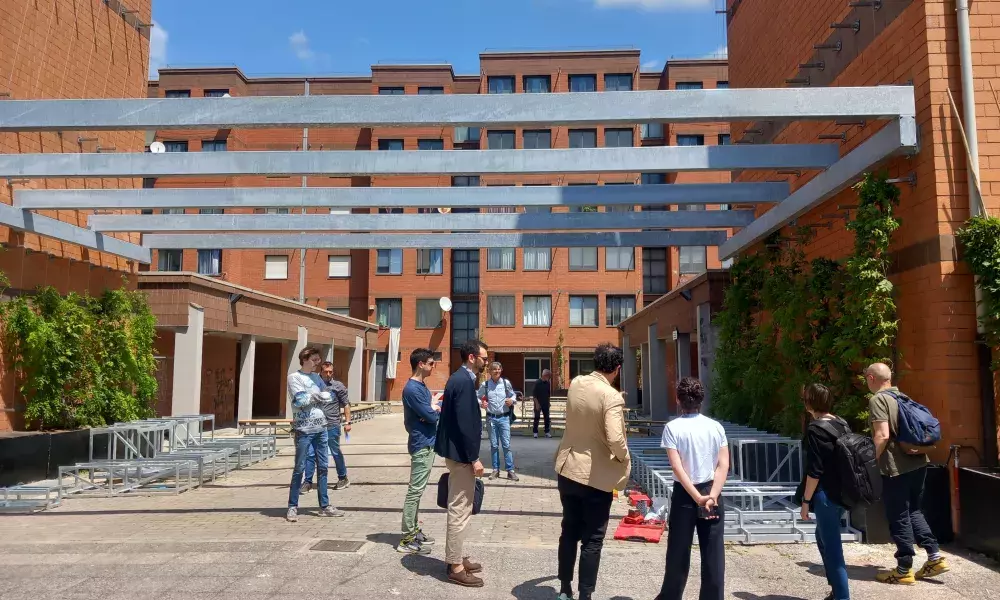
The project conceived by Stefano Boeri Architetti for the Pratese Public Buildings in Via Turchia made use of vegetation for the facades, the demineralisation of the parking area, the creation of a large green pergola at the entrance and the creation of social spaces in the communal garden.
The project started by considering the role of greenery and its significant ecosystem services including the mitigation of pollution caused by road traffic, the absorption of CO2, the production of oxygen, the regulation of the microclimate and the reduction of noise pollution. On a territorial scale, the intervention therefore had the objective of redeveloping the existing urban fabric starting from the principles of securing and implementing nature-based solutions in the urban context of Prato. With this objective, a first punctual intervention took place on the vertical surfaces, with a system of green facades which create, between inside and outside, a vegetal screen of climbing plants.
Thin steel cables were installed on the façades to allow climbing plants to grow, which improved the local microclimate. The project for the Via Turchia residences also deals with the creation of social spaces in the common garden, dedicated to collective and recreational activities, such as social gardens, tables, seating and others. A new large pergola of approximately 100 square metres, covered with creepers and furnished with seating, will be built at the entrance of the complex, between the two buildings to the south of the block.
Via Turchia site. Image by Stefano Boeri Architetti
In the main access to the courtyard at the gap between the two buildings to the south, a green pergola creates a space now used for passage into a resting and meeting place. The principle is on the one hand to symbolically enhance the entrance space and on the other to create a green and shaded area that can be used by all. The beams placed at intervals are connected by stainless steel metal cables and form the support for the climbing plants.
Continuing on, in the central space between the cellars, there arepools with vegetation and seating have been developed to create a new access area suitable for resting and socialising.
As regards the intervention on the existing facades, originally covered with a brick facing, the project has covered the elevations nearly 3000 m2 of climbing vegetation, on a self-supporting structure.
Via Turchia site. Image by Stefano Boeri Architetti
Via Turchia site. Photo by City of Prato
The southern parking area was affected by a soil demineralisation project that transformed 1600sqm of impermeable pavement into a draining surface. One of the objectives of the project was to minimise the consumption of mains water, using where possible the rainwater that will be intercepted and accumulated.
In fact, the project takes into consideration the design of the common spaces, such as the condominium areas or the interstitial space between the residential blocks. In the central space between the buildings and the cellars, used as a garden, a series of common functions have been developed to encourage moments of sociality among the residents of the complex, through various activities: two outdoor educational workshops are arranged around with two existing trees, community vegetable gardens consisting of 4 wooden tubs, a playing area for children and a table with seats.
Due to the great construction and energy costs inflation the project was partially reduced and also received some delays due to bureaucratic processes connected to public procurement. Nevertheless, the project in Via Turchia highlights the importance of involving local communities in being informed at making decisions over the spaces they daily live, as despite the original lack of trust towards the administration and the idea of intervening on green areas, the population was largely engaged. The ambition was originally to combine the efforts of the PUJ project together with national resources for energy efficiency of buildings’ facades which finally didn’t take place. Today, the plants are still small, showing the importance of long term perspectives in designing with Nature-Based Solutions.
About this resource
The Urban Innovative Actions (UIA) is a European Union initiative that provided funding to urban areas across Europe to test new and unproven solutions to urban challenges. The initiative had a total ERDF budget of €372 million for 2014-2020.
Similar content




